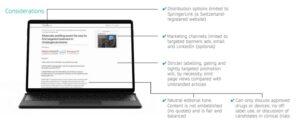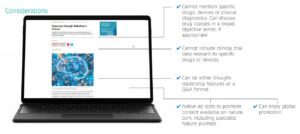Branded or unbranded: Choosing the right content strategy for clinical marketing
 The Internet is the ultimate shop window. Digital platforms are enabling businesses to connect with their customers as never before.
The Internet is the ultimate shop window. Digital platforms are enabling businesses to connect with their customers as never before.
For the healthcare industry, the potential exposure is huge. Research shows that 88.5% of US healthcare professionals search for medical information online either daily or several times a week. But catching your audience’s attention above the constant noise of advertising and content online is a challenge, particularly given the demands HCPs face in their daily lives. A Springer Nature survey revealed that 51% of participating oncologists found it somewhat difficult to very difficult to stay informed, the biggest barrier being a severe lack of time. So for the healthcare industry, the stakes are high. Getting your content marketing right could transform your business, but you need to stand out from the crowd as a trusted source.
Springer Nature’s Clinical Custom Content team are highly experienced in creating content for the needs of healthcare professionals (HCPs) and can provide the guidance you need to create a truly effective content marketing campaign. One of the key issues they’ll address is making the right choice between branded and unbranded content.
First things first—establish your objective
Before we explore the types of content you wish to create, let’s talk about the most important thing to consider. What are your campaign objectives? These will guide your choice of content type and might include:
- Promoting a specific product or range to support adopting and prescribing decisions;
- Raising awareness of your brand, strengthening its visibility in the market and differentiating it;
- Improving customer retention and loyalty;
- Creating an emotional connection with your audience;
- Demonstrating your authority and credibility in your industry.
Once you’ve established what you want to get out of the process, you can progress to developing your content – whether branded or unbranded.
Branded or unbranded content – what’s the difference?
This question is key. You’ll need to understand the differences before you start, if you want your content marketing to be a success.
It’s quite simple.
- Branded content specifically promotes your drug, therapy or medical device. It reads (or sounds) like a promotional piece, driving adoption and prescription by exploring its medical efficacy alongside supporting data and clinical trial results.
- Ozempic’s launch created a huge buzz, with highly memorable creative assets enabling it to stand out from the competition and build a strong, distinct brand. Personal journeys recounted by celebrities, rather than manufacturers’ claims, further enhanced the trust and connection with the brand.
- Unbranded content doesn’t mention your business or products. It focuses instead on your industry, providing your audience with information on issues that are of direct interest to them.
- Pfizer and the American Lung Association’s Quitter’s Circle is an unbranded platform, centred around a community and resources for smoking cessation. Pfizer includes functionality on the app for users to engage with healthcare providers; promoting HCP involvement subtly promotes their visibility amongst potential prescribers and adopters.
How to decide which content type is most suitable
Now you need to match the type of content with your campaign objectives. You’ll almost always use a mix of both types at different stages.
For this type of content that calls for immediate action, your brand identity is key. Make your messaging consistent and prominent – this will reinforce your brand image, boost recognition and help build connections and loyalty with your audience.
If you’re looking to directly promote your products and boost adoption and prescription, go with branded content.

This is also the best option if you’re releasing important news to your audience – your branding will grab their attention.
The branded articles we create at Springer Nature Clinical Custom Content are tightly targeted to specific HCP audiences, addressing their particular needs. They deliver distinct marketing messages with an authoritative tone about approved drugs or devices, and the accompanying promotional campaigns are geographically limited.

If your goals are longer-term, to spread the word and build trust with your audience, go unbranded. Content which educates and is helpful to your potential users will spark interest, establishing you as an authority in your industry. It’s easier to build a more genuine connection by focusing on your audience’s needs rather than on the benefits of your product.
Unbranded, journalistic articles from Clinical Custom Content delivers foundational knowledge about a disease for HCPs, establishing you as thought leader in your field whilst raising awareness of your product. Sitting alongside Springer Nature’s award-winning content, your brand will become associated with a specific research area which is in development.
These articles are marketed more widely, on Nature Portfolio’s journal pages and social media channels.
Clinical Custom Content solutions
Our Clinical Custom Content is created according to your particular needs and objectives. These are some examples of branded content you might wish to consider:
- New product launch – for introducing specialists and other clinicians to a new drug or device, including its benefits, common side effects and clinical results;
- Extended clinical results – when you want to update HCPs with long-term follow-up data for an established drug or device;
- Use cases – for distilling current treatment guidelines around a particular product.
For an unbranded approach, we deliver content such as:
- Expert perspectives – which might entail interviewing a thought leader in your field of choice, or creating a summary of opinion from a conference presentation;
- Disease awareness – exploring the epidemiology, clinical features and key diagnostic aspects of a rare disease or disease subtype;
- Target pathway explainers – examining the disease mechanisms of a condition, including common or upcoming drug targets.
You can also go with either branded or unbranded in some cases:
- Research digest – summarizing an important paper relating to a drug or device (branded) or another aspect of biomedical research (unbranded);
- Conference report – a science-driven summary of discussions from a clinical conference.
Different promotional approaches
All our Clinical Custom Content includes an accompanying promotional campaign for maximum impact with its HCP audiences. We target our approach precisely, varying it according to content type, to remain compliant with regulatory guidance. Unbranded content is targeted at biomedical researchers working in adjacent industries, such as drug development. Promoting branded content is restricted geographically, depending on the countries in which the drug or device in question is approved.
Branded or unbranded – a checklist
To help you decide what type of content is most suitable for you, we’ve created a checklist highlighting the decisions you’ll need to make.
1. Define your objectives
- Influence purchasing decisions (Branded)
- Build loyalty (Branded)
- Reinforce brand identity (Branded)
- Develop new audiences (Unbranded)
- Build trust (Unbranded)
- Establish authority (Unbranded)
Ask:
What do I want to achieve overall?
Who is it for and what are their needs?
What action do I want my audience to take?
Will mentioning my brand increase credibility or is there perceived bias?
2. Understand your audience
- Existing customers, ready to adopt (Branded)
- Potential customers, already trust your brand (Branded)
- Disease/condition-level awareness (Unbranded)
- Raise general awareness (Unbranded
- Skeptical audience (Unbranded)
Ask:
Does your content address the needs of your audience?
Is it sincere, engaging and relevant?
3. Promotion
- Focus on approved drug/device (restricted geographically) (Branded)
- Broad, organic reach, focus on your audience (Unbranded)
- Longer shelf life, with less detail (Unbranded)
Ask:
What channels do my audience frequent?
Finding the right balance for your scientific content
Ultimately, whether you go for branded or unbranded content isn’t about choosing one over the other. It’s about your overall strategy, and aligning the right approach with your objectives and audience. By combining the two, blending the actionable messaging of branded content with the trust-building power of unbranded content, you can maximize your campaign’s success.
Springer Nature’s Clinical Custom Content team can help you strike this balance, ensuring your scientific content stands out in the crowded healthcare landscape. For more information, download our content marketing media kits.
